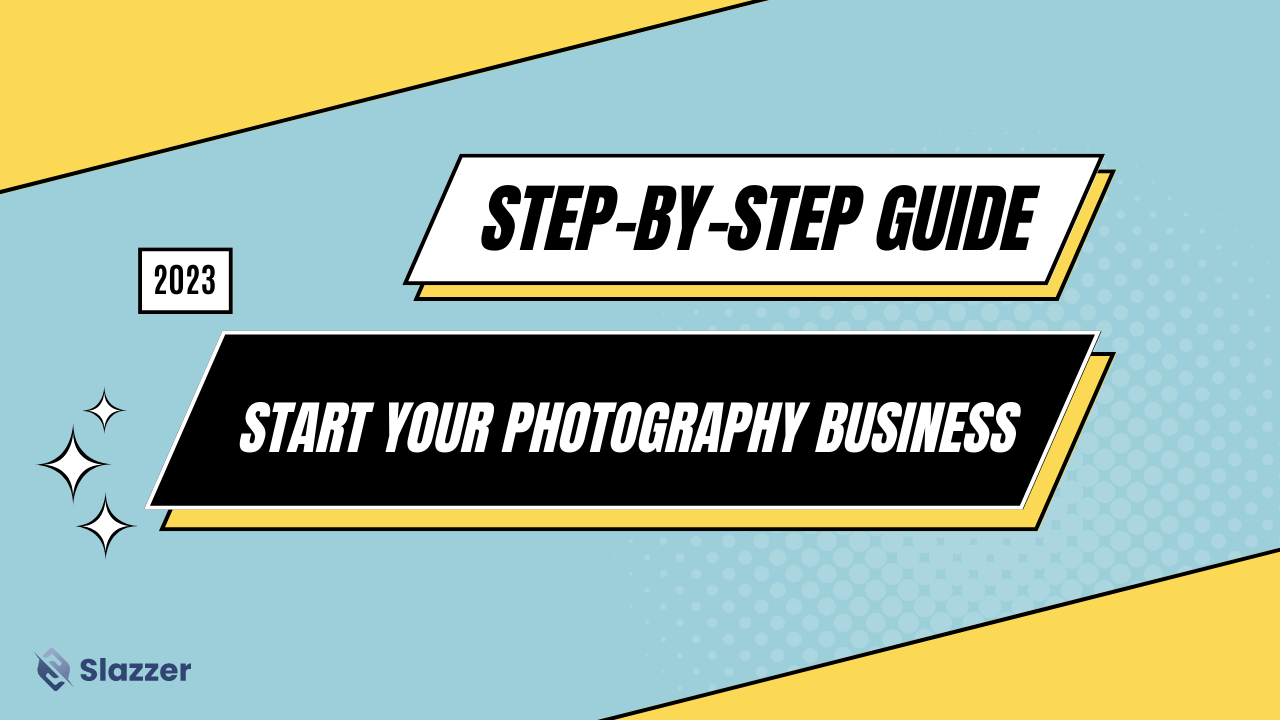- Tips & Tricks
- Aug 29, 2023
A Step-by-Step Guide to Start Your Photography Business in 2023

So you’ve finally decided to turn your passion for photography into a successful business. Starting any business is challenging, but with some planning and perseverance, you can build a thriving photography biz.
The key is to start with the essentials. You already have the skills and eye for great shots, now you need to focus on the business side of things.
This Blog is a guide covering every aspect of starting a successful Photography Business.
Let’s Dive in!
Find Your Photography Niche
To build a successful photography business, you need to find your niche.
Are you a wedding photographer? Food photographer? Pet photographer?
Finding your niche will help you develop expertise and make it easier to market your services.
Think about what subjects ignite your passion. Do you love capturing candid shots of kids playing? Are you fascinated by macro nature photography? Finding your passion will translate into better images and a more compelling portfolio.
Look for holes in your local market. Maybe there are not many portrait or boudoir photographers in your area. Or you notice a lack of photographers capturing local sports teams. Finding an underserved niche in your market gives you a better chance to stand out.
Once you determine your niche, focus on it relentlessly.
The key is to not spread yourself too thin by trying to be all things to all people. Pick a niche you love, that you can excel in, and that fills a need in your market. Double down on it and make it the foundation of your new photography business.
Build a Solid Portfolio of Your Work
To build a solid photography portfolio, start by curating your 10 to 20 best images that demonstrate your skills and style. Include a mix of portraits, landscapes, action shots, macro photography, or whatever your specialty.
Choose a simple yet visually appealing portfolio format like Squarespace, Wix, or Adobe Portfolio that is mobile-friendly, easy to navigate, and effectively highlights your work. Keep text minimal and let your images speak for themselves.
Share your portfolio on social media to gain exposure. Post images from your collection on Instagram, Facebook, and LinkedIn, using a consistent style for your posts. Engage by responding to comments and following other photographers and potential clients.
Reach out to prospective clients like real estate agents, event planners, and marketing firms to offer your services. Meet with them to show examples of your work and discuss how you can meet their needs.
Start small – building experience will strengthen your portfolio over time. Curating a smaller, high-quality selection of work will make a better impression than a large collection of mediocre photos.
Create a Business Plan
Creating a solid plan is crucial to making your photography passion a successful business. The plan acts as a roadmap, outlining your vision, goals, and challenges.
- Define your vision clearly. Decide the type of photography: weddings, portraits, products, or other. Clarify your style and ideal clients. This shapes your brand and marketing.
- Set specific, measurable goals to work toward. Build your portfolio, create a website, or book several clients in the first year. Break larger goals into smaller steps. Achieving steps keeps you motivated and accountable.
- Anticipate challenges. Running a business is difficult. Consider obstacles like seasonal demand changes, equipment costs, and marketing difficulties. Determine solutions to overcome them. Talking to other photographers helps identify common issues.
- Create financial projections. Forecast income and expenses to determine profitability. Decide your offerings, fees, startup costs, and overhead. Look for ways to minimize costs, initially. Financial projections show if you can pursue photography full-time and when.
This framework provides a foundation for building a successful photography business. Adapt your plan to account for industry and market changes.
Determine Your Pricing Strategy
Now that you have the gear and skills, it’s time to determine how much you should charge your clients. Pricing yourself correctly is key to building a sustainable business.
Think about your target customers and what they can afford. You’ll want to consider:
- The experience and quality of your work. If you’re just starting, you’ll charge less than an established pro. But don’t undervalue yourself either.
- What do other local photographers charge? Do some research on their rates to determine a competitive price range. You can offer promotions and discounts to attract new clients.
- The types of photos you’ll be taking. For example, wedding photography will be priced higher than family portraits. Commercial work for businesses will also typically pay more.
- How much time and effort each job will require? Factor in not just the shooting time but also editing, travel, and consultations.
You have flexibility in how you structure your fees. You can charge by the hour, per image, or package rates for a full photoshoot and set of edited images. Many photographers offer a combination of these options. You may start with lower rates as you build your portfolio and client base, then increase over time as demand for your services grows.
The key is not to undercut the competition but instead focus on the value you provide to clients. If you deliver high-quality work and a great experience, you deserve to charge fair prices. Don’t be afraid to take on clients at your full rate. You can always negotiate for long-term or high-volume clients.
With some trial and error, you’ll find the sweet spot that keeps customers booking you for more work.
Set Up the Legal and Financial Aspects
Once you have the photography skills and equipment in place, it’s time to set up the legal and financial aspects of your business. This step is not very exciting, but it’s essential to operating legally and professionally.
You’ll need to determine your business structure, like whether you want to register as a sole proprietor, partnership, or corporation. Then officially register your business with your state. This typically involves filing paperwork, like articles of incorporation, and paying a small registration fee.
Next, you need business licenses or permits to operate legally. Requirements vary in each city and state, so check with your local government. Common licenses for photographers include a general business license and a sales tax permit.
Don’t forget insurance! As a professional photographer, you should have commercial general liability insurance(CGL) and possibly other policies like business property or professional liability insurance. Insurance protects you in case of lawsuits, accidents, or disasters.
Then set up separate business banking and accounting. Keep your business revenue and expenses separate from your finances. Open a business bank account and use accounting software like QuickBooks to properly track income, expenses, and tax obligations.
Following these essential steps will ensure your photography business is set up properly from a legal and financial perspective.
Build Your Marketing Plan
Build a marketing plan for your photography business by identifying your target clients and photography services. Defining your niche helps determine how to reach customers.
Create profiles on Facebook, Instagram, and LinkedIn. Post eye-catching photos, share behind-the-scenes clips, and engage followers and clients. Build an email list through a regular newsletter with promotions for subscribers.
Network locally by joining your chamber of commerce and attending events. Volunteer to photograph charity and community events. Donating your services gains exposure to new clients.
Build a professional website showcasing your photos, services, and prices. Make it easy for people to contact you for quotes and bookings. Run ads on social media and search engines to drive traffic.
Offer specials like mini-sessions, package deals, and referral programs. Provide excellent service and stunning photos so happy clients refer your business.
Networking: Connect With Fellow Photographers and Potential Clients
Networking is key to building your photography business. Connecting with fellow photographers and potential clients can lead to new opportunities and collaborations.
First, reach out to other photographers in your area. See if they’d be open to grabbing coffee or chatting over the phone.
Ask them about their experiences building up their business. What worked? What didn’t? Pick their brain on the local market and rates. They may even refer overflow work your way.
Look for networking events geared toward photographers and creative professionals. Attend industry meetups, portfolio reviews, and workshops. Introduce yourself to people with a firm handshake, friendly smile, and your business card. Follow up and stay in touch with anyone who seems genuinely interested in your work.
Don’t forget about your social media platforms. Engage with followers by posting behind-the-scenes photos from recent shoots. Share tips and tricks you’ve learned. Respond to comments and messages. All of these small interactions can help raise your visibility and build new relationships.
Potential clients are everywhere, so always be on the lookout. Strike up a conversation with vendors at wedding expos or parents at school events. Let people know you’re a photographer looking to take on new clients. You never know who may need your services down the road or spread the word about your business through word-of-mouth.
Staying active and connected in your local community can lead to a thriving photography business.
Continuous Learning: Keep Improving Your Craft
Continuous learning is key to improving your craft and staying ahead of trends in photography. Some ways you can strengthen your skills:
- Take online courses or watch tutorial videos. Sites like CreativeLive, Skillshare, and Udemy offer affordable classes on everything from natural light portraiture to marketing your photography business.
- Practice new techniques. The only way to learn is by doing. Try shooting in manual mode, experiment with different lenses and lighting setups, or follow tutorials to master new editing skills.
- Stay up-to-date with industry news. Read photography blogs and magazines to learn about new gear, apps, post-processing methods, and business strategies. Some highly-rated options are Digital Photography School, PetaPixel, and Rangefinder.
- Get feedback from fellow photographers. Share some of your images on photography communities and ask others to provide constructive criticism. Then incorporate their notes into your next shoot.
- Assist an experienced photographer. There’s no better way to gain valuable on-set experience than by second shooting for a pro. Reach out to photographers in your area and offer to assist them at no charge in exchange for the learning opportunity.
While the technical and creative aspects are important, you also need to strengthen your business and marketing skills.
Conclusion
So there you have it, a guide to starting your photography business. It won’t happen overnight, but if you commit to the process and see each step through, you’ll be well on your way to working for yourself and doing what you love.
Happy Clicking!


Comments (0)